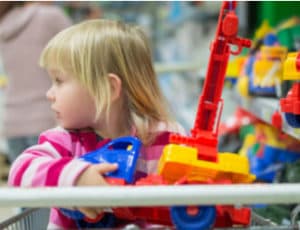Connecticut Toy & Children's Products Injury Attorney

Children are delicate and do not have the judgment of adults. They often put small or broken bits of objects into their mouths, use toys in ways other than their intended use, and take risks because they don’t yet understand how an action might lead to harm.
Designers and manufacturers must take a child’s natural curiosity into account in order to make safe, reliable children’s products. When a child’s toy or other product poses a risk, distributors must be sure to pull defective products from their shelves. If designers, manufacturers, or distributors fail, the consequences can be catastrophic.
If your child suffered due to defective children’s products, call Kocian Law Group. We can help you recoup medical bill losses, cover rehabilitation, and garner justice from those who have wronged your child.
Defective products can be the fault of the designer, the manufacturer, the distributor, or a combination of these parties. A product can work as intended, but still be faulty if the designer did not take into account the actions of a small child. For example, a counting game that included many small marbles may work as it is intended, but it can also pose a danger to young children who may choke on the small pieces.
A product can also have a solid design, but come into trouble when it gets to the manufacturing stage. High-quality materials and building processes must be used to ensure children’s toys are made of safe, sturdy materials that won’t come apart and create a risk of sharp edges, choking hazards, or other dangers.
Finally, a distributor can fail to account for a faulty product. Consider a situation in which a line of toys is recalled for being dangerous. If your local toy store fails to pull the dangerous toy from its shelves in a reasonable period of time despite knowing about the recall, the store could be liable for damages the toy causes.
Types of children’s products that have high incidence of malfunction are:
- Car seats: Improper buckling or failure to protect in case of an accident can easily occur.
- Nursery equipment: Changing tables can collapse. A child can get his or her head stuck in between the bars of a crib. Bottles may come apart or break, creating sharp edges or a choking hazard.
- Toys: Anything with small parts or likely to break into small parts poses a threat. Also, toys that are likely to go in a child’s mouth must be constructed with safe materials. Many toys have been recalled due to being made of dangerous materials, such as lead paint. If ingested in sufficient quantities, lead paint can cause brain damage or death.
Many types of defects in children’s toys can cause injuries, including:
- Small parts: A product for very young children should not contain small parts. If it does, this could be a design or manufacturing flaw which could cause choking or suffocation.
- Unsafe materials: Lead paint, dangerous chemicals, and other substances pose serious health risks.
- Sharp, pointed, or jagged edges: These can cause cuts, puncture wounds, and eye damage. A toy that has sharp parts when taken apart can still be considered defective.
- Too loud: Some loud toys can cause hearing damage in small children
- Overheating: Electronic toys can get very hot. Sometimes even battery powered toys become unacceptably hot and lead to burns.






